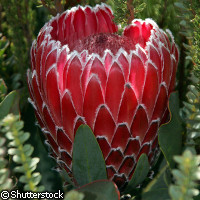New family tree sheds light on origins of species 'hotspots'
A new family tree of proteas (commonly known as sugarbushes) reveals that new species of these plants are appearing three times faster in biodiversity hotspots in Australia and South Africa than in the rest of the world. The findings, published online by the Proceedings of the National Academy of Sciences (PNAS), shed new light on the evolutionary origins of biodiversity hotspots, and could help to improve efforts to protect these species-rich areas, many of which are under threat from human activities. The work was supported in part by the EU through the HOTMED ('Evolutionary origin of biodiversity hotspots with a Mediterranean climate') Marie Curie Outgoing International Fellowship, which was financed under the Sixth Framework Programme (FP6). The regions examined in this study, the Cape Floristic Region of South Africa and South Western Australia, are two of five regions in the world with a Mediterranean climate, the others being central Chile, California and the Mediterranean basin itself. These regions are among the most species-rich on Earth and as such are widely recognised as 'biodiversity hotspots'. However, until now the reasons for these regions' exceptional species richness have remained a mystery. The Cape Floristic Region and South Western Australia are characterised by high levels of endemism (i.e. many of the species found there are unique to that region), nutrient-poor soils and frequent fires. Both are also home to large numbers of protea species. There are around 2,000 species of protea on Earth, all found in the southern hemisphere, mostly in South Africa and Australia. The plants come in a diverse array of shapes and sizes, from low-growing shrubs to 35-metre-tall trees. They have leathery leaves and cup-shaped groupings of brightly coloured flowers. Notably, the protea is the national symbol of South Africa. In this study, the international team of scientists put together an evolutionary 'family tree' of all the protea species in the world. The tree reveals that proteas in the two regions under study are evolving around three times faster than proteas elsewhere in the world. Furthermore, this burst of species formation took place in the past 10 to 20 million years, after a period of climate change left both South Africa's Cape region and South Western Australia hotter, drier and more prone to wildfires. Proteas are known to be drought resistant and able to re-grow quickly after a fire. As the climate changed, species that could not adapt to the changed conditions became extinct, while proteas thrived and diversified because there was less competition from other plants. 'Something special is happening in these regions: new species of proteas are appearing notably faster than elsewhere, and we suspect this could be the same case with the other plant species too,' commented Dr Vincent Savolainen of the UK's Imperial College London and the Royal Botanic Gardens at Kew. 'This study proves that the abundance of different kinds of proteas in these two areas isn't simply due to normal rates of species diversification occurring over a long time. 'This is the first step towards understanding why some parts of the planet with a Mediterranean-style climate have become species-rich biodiversity hotspots. Understanding more about the evolutionary history of these biodiversity 'hotspots' is important because it can help make conservation efforts more efficient,' he concluded.
Countries
Australia, South Africa

